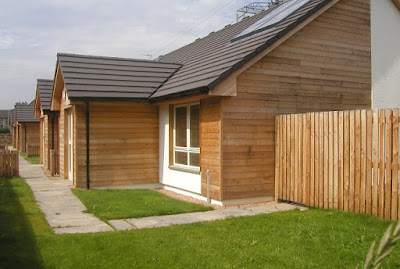Natural Building Materials
It is a common misconception prevailing
in the minds of builder and owners that the more exotic the materials are used
for construction the more attractive and longer lasting the structures would
remain. Even when the locally available materials are used, the built
structures will display the strength and long endurable vitality. They could
easily withstand climatic extremities of that particular region and the
building also looks perfectly coalesced one with the surrounding ambience.
It is quite common to find sea facing
buildings showing signs of premature ageing, the window frames corroded, walls
darkened, the paint peeling off because of the high levels of salt content.
Climate has a very important role to play in the maintenance of buildings. The
type of materials used, the method of construction opted determine the heath of
a building.Local materials like sand and stone are normally structured to suit
the climatic conditions of the place.
Hence, when buildings are constructed using locally available materials,
invariably the structures display the strength to withstand the extremes of
climate in that particular region. In such cases, climatic erosion of buildings
is least.
The type of architecture of a place too
reflects an adherence to this climatic factor as buildings have to be naturally
adapted to tackle extremes of climate in the absence of artificial means of
support. Thus a cold place would reflect more of wood based structures to
retain the warmth, a more tropical climate would display high ceilings to
eliminate the circulation of hot air.Currently buildings use materials as well
as designs that are based more on styles suited to taste than to the local
climate. For instance, the typical Kerala architecture encompasses sloping
roofs and wide corridors to tackle the heavy rains. However, the modern structures do not display
such conformity with local requirements.
Similarly, the stones used in some of
the old buildings in Mumbai have withstood the test of time as well as climate.
The same cannot be said of the more current buildings where locally available
materials have not been used. Again, the locally available laterite stones in
Mangalore are best suited to tackle the heavy rains and the sea in the coastal
belt but how many local buildings use it is a totally different question.
Though thematic buildings break the
monotony by bringing in a novelty to a structure, many a time, the design as
well as the materials used imported from a different place, do not fit in, giving
rise to defects.To avoid such mismatch and the resulting problems, it is best
to go in for structures that are inherently suited to local climatic
conditions. However, there are materials
like steel which every modern building cannot dispense with irrespective of its
location. While steel does not get corroded easily, it is important to go in
for the right type of steel which is treated for anti corrosive properties to
be used in coastal areas as otherwise it can prove to be risky for the buildings.
Similarly non-ferrous materials like
aluminium, polymer and wood should be used in coastal areas to prevent rusting.
Wood, when seasoned well, can withstand the worst of climates. Of course the
wood used here should be stable wood.Modern buildings also sport more of glass
walls than brick structures. If these glass walls face the South or West, the
building is sure to heat up. The situation is worse if glass walls face south
west as the maximum heat is from this direction. Bricks, terracotta tiles and stones are best
suited to insulate the building from heat.
Another factor that leads to
overheating of interiors is the absence of sunshades for windows. Traditional buildings not only used less of
glass but the windows too sported wooden doors protected by sunshades. These
sunshades not only acted as shields from the sun but also kept out the rain.
These recessed windows were marvelous protectors from the harsh climate.
While it is best to use locally
available materials and conform to local architecture to reap the maximum
benefit in terms of climate tolerance, it is not feasible to do so at all times
as other factors such as lifestyle, the use the building is to be put to have a
say in the design. It is then best to compromise in a manner that the building
continues to be climate friendly albeit the modern design. And this compromise
can be achieved by opting for local materials wherever possible and arriving at
a design that is sensitive to local conditions.
For
More...........:

No comments:
Post a Comment